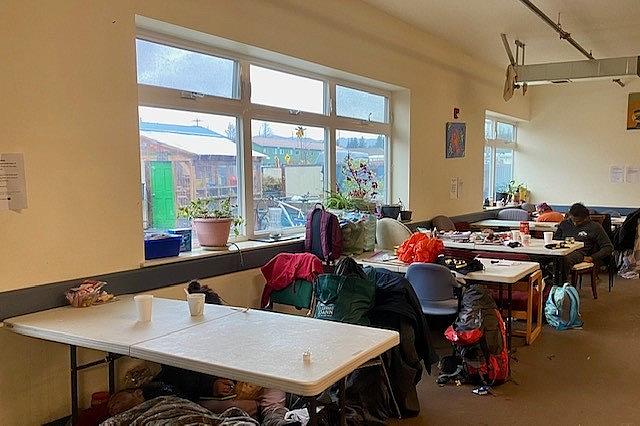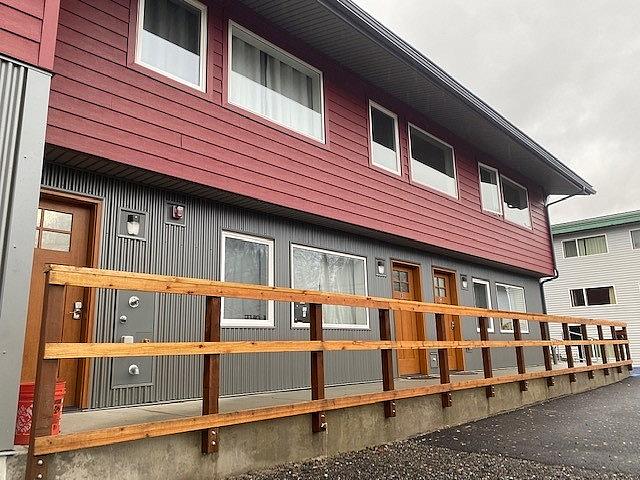Domestic violence is feeding Alaska’s homelessness crisis
The story was originally published by Alaska Beacon with support from our 2023 Domestic Violence Impact Fund.

An encampment of homeless people is off of 1st Avenue in Anchorage on Nov. 21, 2023.
Photo by Andrew Kitchenman/Alaska Beacon
Domestic violence is a leading cause of homelessness for women and their children. Alaska’s major cities are struggling to manage homelessness, especially in the winter, when the stakes for survival are even higher. And experts have identified domestic violence as one of the faucets that floods cities with homelessness.
“Probably every woman in here has experienced domestic violence,” said Mariya Lovishuk, the director of Juneau’s emergency shelter, The Glory Hall. “Most women who come to us have experienced domestic violence at some point in their lives. Maybe not yesterday, but definitely it was very serious, and it has impacted them.”
Lovishuk said that not only does the statewide dearth of affordable housing keep people unhoused longer, but it can keep them in abusive relationships longer, too. “Even if they want to leave… going to shelter is not a very appealing option. So they just stay,” she said.
Lovishuk said that because shelters can be chaotic places, she sees some people stay in abusive situations rather than navigate them alone.

Coats are hung on chairs at communal tables in the main dining room of The Glory Hall, Juneau’s homeless shelter, on Nov. 21, 2023.
Photo by Claire Stremple/Alaska Beacon
She said the extensive paperwork for affordable housing programs can take months, and for people who want to flee domestic violence, that wait can outlast their resolve to leave: “What we see is people who are in domestic violence relationships give up,” she said.
Abuse commonly compromises victims’ economic stability. For example, it can result in eviction due to disturbances at home, job loss from missing work or poor credit from a partner’s financial actions. That, paired with a lack of affordable housing in the state, often results in homelessness — nationally, most women who experience homelessness have been victims of domestic violence.
In Alaska, where nearly 20% of adults who experience homelessness said they had a history of domestic violence, some emergency shelters are building long-term and permanent housing to keep families safe.
A growing need
In Anchorage, where the vacancy rate for rentals is under 5%, homelessness complicates the response to domestic violence. At Abused Women’s Aid in Crisis, or AWAIC, the largest women’s emergency shelter in Alaska, director Suzi Pierson said that homelessness has devastated the community.
“You’ve got more people in camps, more people at risk,” she said. “You know, in close living conditions, when you’re talking about some of the camps, it’s very dangerous, and the level of violence and drugs and all those things are in the camps. So it’s really not safe for victims of domestic violence. They’re even at higher risk for any other kind of crime.”
Emergency shelter saves lives. Absolutely. But it’s also a trap, in some ways, for repeated bouts of poverty and homelessness.
– Mandy Cole, director of Juneau's domestic violence shelter
As a result of the state’s housing crunch and resultant uptick in homelessness she has seen the average shelter stay lengthen — and more clients from rural areas.
“We end up having people stay here for months, because of the lack of housing,” she said.
The challenge with longer stays is that there are fewer beds available for people in crisis, Pierson said. Shelters measure risk by what’s known as “lethality,” a chilling metric that refers to the likelihood someone will be injured or killed. Shelter managers like to have beds open in case a person with high lethality is in need of shelter. In 2021, her shelter expanded from 52 to 67 beds.
“You want more housing, so you can support people getting into housing that are not staying in your shelter for long periods of time, so that you have beds that are available for those in emergent situations,” she said.
“Our vacancy rate for shelters in the community is at zero,” Pierson said. “So, we’re all full here.”
The shelter still makes room for people in emergencies and screens calls to prioritize those who need shelter most, Pierson said. But the shelter doesn’t have the capacity to build or manage housing for survivors of domestic violence.
Building a solution
The Fairbanks shelter manages nearly two dozen units of housing for survivors of domestic violence, the Bethel shelter is working towards more permanent supportive housing, and this year, Juneau’s domestic violence shelter built seven units of permanent housing. Mandy Cole, the director of local nonprofit Aiding Women in Assault and Rape Emergencies, said it is the thing survivors want most.
“If you can control the door to your home, you control who has access to your family, to your body,” she said. “There’s no daylight between healing and surviving domestic and sexual violence and independent, safe, affordable housing.”

Cordova Street apartments sit in the rain on Nov. 16, 2023. The Juneau shelter invested in eight units of permanent supportive housing to keep survivors of domestic violence safe and housed.
Photo by Claire Stremple/Alaska Beacon
She said the shelter she runs was aware of the housing crisis long before it became a statewide issue. The shelter’s residents had trouble leaving due to a lack of safe, affordable housing options.
By 2012, the shelter had added housing strategies to its long-term plans because she said emergency shelter is not a housing solution.
“Emergency shelter saves lives. Absolutely. But it’s also a trap, in some ways, for repeated bouts of poverty and homelessness,” she said. “This is not a controversial idea. It is not one that everybody knows or understands or wants to talk about, but the data bears this out pretty clearly: that if generations of families live in emergency shelter, they have a very difficult time kind of getting out of poverty and violence and victimization and the repeated cycles of these things over their lifetimes and over family generations.”
The shelter started with transitional housing programs, then expanded to provide financial support through what is known as rapid rehousing. Cole said that this support is crucial to protecting people who leave situations of domestic violence because they are extremely vulnerable to homelessness.
“With people who are just kind of getting back into the workforce, if one tiny thing that happens — you know, a couple of days without child care or transportation issues or a medical issue — they lose their housing for it,” she said. “Whereas people who have more means can absorb some of those things, people who live on the margin just cannot.”


